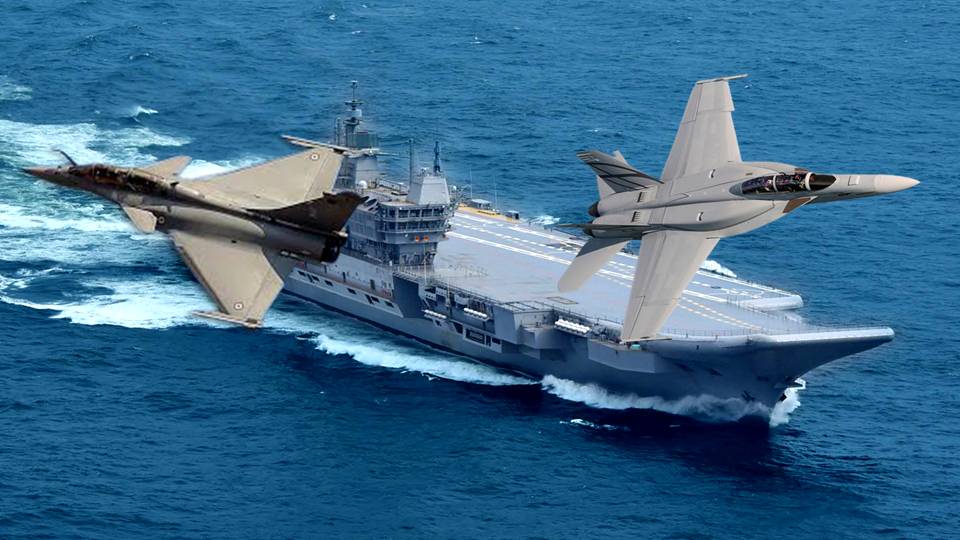As Indian fighter jets are aging and indigenous development of fighter jets are on a progressing path, India is in buyout mode to urgently fill the required 42-squadron strength of combat aircraft. Having already acquired 36 Rafale fighter jets in fly-away condition, the government is ready to buy another 114 multi-role fighter aircrafts under the ‘Buy Global & Make in India’ program for the Indian Air Force. Now, the government is also in the process of replacing its MiG-29Ks with new fighter jets for the Indian Navy.
It is expected that India’s first indigenous Aircraft Carrier, INS Vikrant, will formally be commissioned into the Indian Navy in August. With an endurance capacity of 7500 nautical miles at the speed of 18 knots, the Aircraft Carrier will have a consortium of 30 fighter aircrafts. But considering the aging of already used MiG-29Ks, the Indian Navy is hoping to buy future fighter jets for its indigenous aircraft carrier.
Rafale vs F/A-18
Most of the fighter jets used by the Navy have to be compatible with the aircraft carrier through which they operate. Since the Aircraft carrier works as a moving runway, the fighter jets on board have to be specialized in the conditionality of short-run flying and landings.
Although, MiG29K would have had a better compatibility, but the growing diversification of defence procurement and changing geopolitical conditions are forcing India to come up with some alternate options. In the options available, the Navy is testing two types of deck-based fighter jets, Rafale Marine from France and F-18 Super Hornets from the US, for its INS Vikrant.
Although, MiG29K would have had a better compatibility, but the growing diversification of defence procurement and changing geopolitical conditions are forcing India to come up with some alternate options. In the options available, the Navy is testing two types of deck-based fighter jets, Rafale Marine from France and F-18 Super Hornets from the US, for its INS Vikrant.
In February this year, India successfully flight-tested the French-made Rafale Marine fighter jet at a shore-based facility in Goa. Similar to Rafale, the Rafale Marine version is also a 4.5th generation twin-engine, canard delta wing, multirole fighter aircraft. The Rafale is capable of performing omni-role functions like aerial reconnaissance, ground support, in-depth strike, anti-ship and nuclear deterrence missions. In its testing of take-off capabilities from the deck of INS Vikrant, the Rafale Marine had performed very well.
The main contender for India’s requirement, F/A-18 Super Hornet, was tested later in May 2022. According to Boeing, the F/A -18 Super Hornet Block 3 is the world’s most advanced, combat-proven, multi-role frontline naval fighter that offers unique and differentiated capabilities. It is also fully compatible with the Indian Navy Aircraft Carriers like INS Vikramaditya and INS Vikrant. The F/A-18 Super Hornet has been designed and built for carrier operations and is able to operate on the deck, in the hangars, and on the lifts of the Indian Navy’s aircraft carriers.
The F/A-18 Block 3 Super Hornet uses the same family of engines that are powering India’s indigenous Light Combat Aircraft (LCA). Boeing also pledged to start the supply chain capabilities by partnering with the local industries in India itself.
Read More: Buy Global & Make in India: India will procure fighter jets under the MRFA deal in 3 phases
The winner is F/A-18 Super Hornet
Considering the geopolitical conditions and battle-proven capabilities of the F/A-18 Super Hornet, the American company is going to win the required tender for the Navy’s aircraft. F/A-18 is a versatile deck-based fighter jet and Boeing is ready to offer manufacturing facilities for fighter jets here in India. Further, the acquisition of F/A-18 will prove to be the new dawn in the Indo-American strategic relationship.
As the partnership with the French is already going for the 114 multi-role combat aircrafts for the Indian Air Force, the cooperation with the Americans will be fruitful considering India’s long-term plan for diversification of defence procurement. Strategic cooperation in defence and security provides long-term stability in the countries’ relationships.
In the age of uncertainty, India is trying to balance its relationship with global powers, and a long-term defence cooperation provides leverage in fructifying the goal. The recent CAATSA (Countering America’s Adversaries Through Sanctions Act) waiver by the US Congress against the purchase of Russian S-400 is an effort by the Americans to increase their strategic relationship with India. The buying of the F/A-18 Super Hornet by India can be considered reciprocity of the CAATSA waiver.
Support TFI:
Support us to strengthen the ‘Right’ ideology of cultural nationalism by purchasing the best quality garments from TFI-STORE.COM
